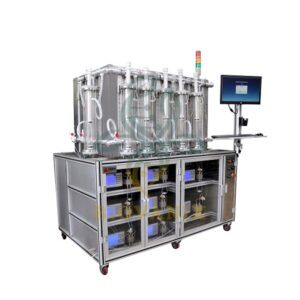SMB (Simulated Moving Bed) Chromatography System
Innovative Solutions for Efficient Separation
Biovanix SMB (Simulated Moving Bed) Chromatography System is an advanced continuous chromatography separation technology widely used in chemical, pharmaceutical, and food industries. By simulating the movement of the stationary phase, the SMB system achieves highly efficient and stable separation effects, significantly improving production efficiency and product quality.
Biovanix SMB system connects multiple chromatography columns into a loop system, divided into functional zones such as adsorption, elution, and regeneration. By periodically switching valves, the stationary phase is made to “move” relative to the mobile phase, achieving continuous sample injection, separation, and collection.

Advantages
High Efficiency
Low Solvent Consumption
High Purity and High Recovery Rate
Continuous Operation
Technical Specification
Customization
We offer comprehensive technical support and services, including system installation, commissioning, training, and after-sales maintenance, to ensure that customers can operate the SMB system smoothly.
1. Separation Efficiency
- Purity: SMB chromatography is designed to achieve high-purity separation, with product purity often reaching above 99%.
- Recovery Rate: With optimized operating conditions, the recovery rate in SMB chromatography can approach 100%.
2. Operating Parameters
- Flow Rate: The flow rate of the mobile phase is a critical parameter, typically optimized based on the separation target. The flow rate range is generally between 0.1-10 L/min.
- Switching Time: The valve switching time is an important operational parameter in SMB systems, determining the “movement” speed of the stationary phase relative to the mobile phase. The selection of switching time needs to be optimized based on the adsorption characteristics of the substances being separated.
- Feed Rate: The amount of feed introduced into the system directly affects separation efficiency and the system’s production capacity.
3. System Configuration
- Number of Columns: SMB systems typically consist of 4-12 chromatographic columns.
- Column Dimensions: Including column length, diameter, and packing volume, these parameters influence separation effectiveness and the system’s processing capacity.
4. Economic Indicators
- Solvent Consumption: Compared to traditional batch chromatography, SMB chromatography can reduce solvent usage by 20-50%.
- Adsorbent Usage: SMB chromatography can save up to 50% of adsorbent.
- Operating Cost: Long-term operating costs can be reduced by 50%, primarily due to the savings in solvent and adsorbent usage.
5. Control and Optimization
- Control Strategy: Modern SMB systems often employ advanced control strategies, such as Model Predictive Control (MPC) and Moving Horizon Estimation (MHE), to achieve efficient separation.
- Optimization Parameters: These include isotherm models, mass transfer resistances, and cycle switching times.
6. Other Indicators
- Temperature Range: Typically between 5-80°C, depending on the nature of the substances being separated.
- Pressure Range: Operating pressure is generally between 0.1-10 MPa.

